| EDEM2 |
|---|
|
| Identifiers |
|---|
| Aliases | EDEM2, C20orf31, C20orf49, bA4204.1, ER degradation enhancing alpha-mannosidase like protein 2 |
|---|
| External IDs | OMIM: 610302; MGI: 1915540; HomoloGene: 10075; GeneCards: EDEM2; OMA:EDEM2 - orthologs |
|---|
| Gene location (Human) |
|---|
 | | Chr. | Chromosome 20 (human)[1] |
|---|
| | Band | 20q11.22 | Start | 35,115,364 bp[1] |
|---|
| End | 35,147,336 bp[1] |
|---|
|
| Gene location (Mouse) |
|---|
 | | Chr. | Chromosome 2 (mouse)[2] |
|---|
| | Band | 2|2 H1 | Start | 155,543,597 bp[2] |
|---|
| End | 155,571,395 bp[2] |
|---|
|
| RNA expression pattern |
|---|
| Bgee | | Human | Mouse (ortholog) |
|---|
| Top expressed in | - granulocyte
- monocyte
- right lobe of liver
- islet of Langerhans
- right adrenal gland
- body of pancreas
- left adrenal gland
- mucosa of transverse colon
- decidua
- right adrenal cortex
|
| | Top expressed in | - lacrimal gland
- decidua
- islet of Langerhans
- salivary gland
- parotid gland
- crypt of lieberkuhn of small intestine
- pyloric antrum
- seminal vesicula
- epithelium of stomach
- submandibular gland
|
| | More reference expression data |
|
|---|
| BioGPS |  | | More reference expression data |
|
|---|
|
| Gene ontology |
|---|
| Molecular function | - calcium ion binding
- mannosyl-oligosaccharide 1,2-alpha-mannosidase activity
- catalytic activity
| | Cellular component | - endoplasmic reticulum lumen
- endoplasmic reticulum
- membrane
- endoplasmic reticulum quality control compartment
| | Biological process | - endoplasmic reticulum unfolded protein response
- mannose trimming involved in glycoprotein ERAD pathway
- N-glycan processing
- positive regulation of retrograde protein transport, ER to cytosol
- response to unfolded protein
- ubiquitin-dependent glycoprotein ERAD pathway
- trimming of terminal mannose on B branch
- trimming of terminal mannose on C branch
- trimming of first mannose on A branch
- trimming of second mannose on A branch
| | Sources:Amigo / QuickGO |
|
| Orthologs |
|---|
| Species | Human | Mouse |
|---|
| Entrez | | |
|---|
| Ensembl | | |
|---|
| UniProt | | |
|---|
| RefSeq (mRNA) | | |
|---|
| RefSeq (protein) | | |
|---|
| Location (UCSC) | Chr 20: 35.12 – 35.15 Mb | Chr 2: 155.54 – 155.57 Mb |
|---|
| PubMed search | [3] | [4] |
|---|
|
| Wikidata |
| View/Edit Human | View/Edit Mouse |
|


















